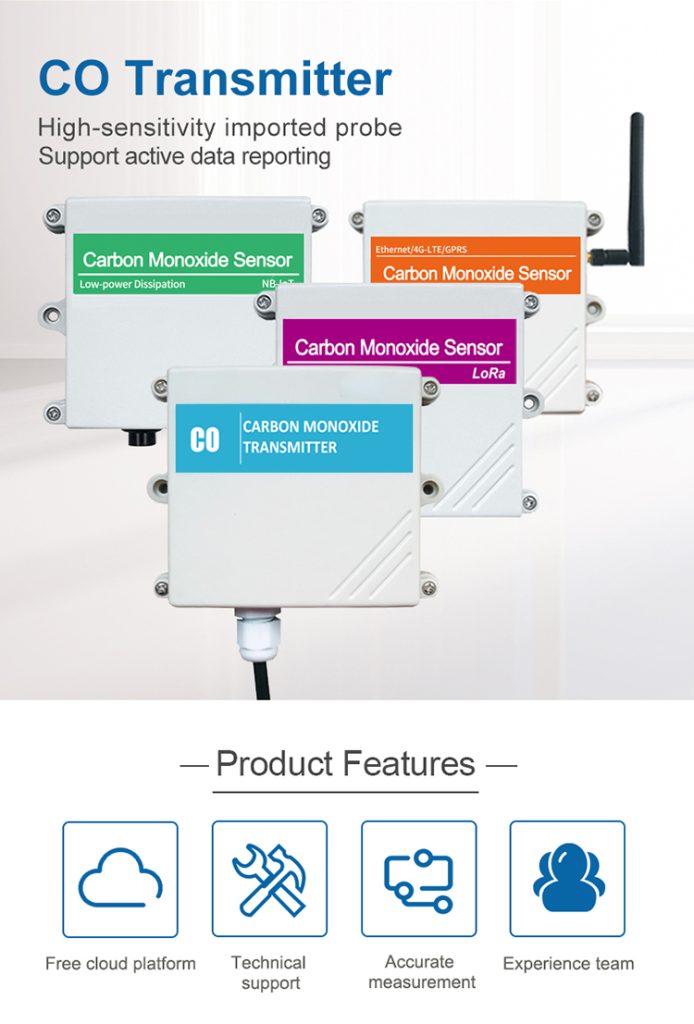1. What is carbon monoxide? What does CO do to the body?
Carbon monoxide gas is colorless, odorless, and difficult to be discovered. But people are very dangerous if they are in carbon monoxide, and even threaten their lives. At room temperature, carbon monoxide can mix with air to form an explosive mixture. It can cause combustion and explosion in the case of open flames and high temperatures. It is a flammable and explosive gas.When the body inhales excessive carbon monoxide, hemoglobin will lose its ability to carry oxygen and cause suffocation, and even death in severe cases.We can use CO sensor for online monitoring.
2. What is carbon monoxide sensor working principles?
According to the reaction principle of the sensor, carbon monoxide sensors are mainly divided into the following categories, and have the following advantages and disadvantages:
1. Semiconductor Principle
Working principle: The sensitivity of the semiconductor sensor to gas depends on the temperature at which the sensitive element is heated. For the detection of carbon monoxide, the optimal temperature for the sensitive element to be heated is below 100″C. This temperature is much lower than the detection temperature of other gases (such as butane, methane, hydrogen, ethanol vapor, etc.). However, in this way At low temperatures, the response speed of carbon monoxide decreases, and its sensitive characteristics are easily affected by water vapor in the atmosphere.
Advantages: cheap price and excellent performance.
Disadvantages: high power consumption, not suitable for battery power supply, easy to be affected by temperature, humidity, airflow, etc., poor anti-interference ability, and high false alarm rate.
2. Principle of catalytic combustion
Advantages: accurate measurement, fast response, and long life.
Disadvantages: within the flammable gas range, no selectivity. Work in a dark fire, there is a risk of ignition and explosion. Most elemental organic vapors have a poisoning effect on the sensor.

3.Electrochemicalprinciple
The overall reaction is that carbon monoxide is oxidized to carbon dioxide, the electron flow forms an external current, and the charge balance is completed by the flow of carriers in the electrolyte.
The biggest feature of the electrochemical carbon monoxide sensor is: the current is completely proportional to the carbon monoxide concentration, and the output signal has a good linear relationship with the gas concentration, so the signal processing and display are very convenient. Another feature is that, because it is a reaction at room temperature, no heater is needed, so the battery between the electrodes can use dry batteries, no commercial power, and it is easy to carry a carbon monoxide alarm.
Of course, it is obvious from the detection principle that the gas selectivity of electrochemical sensors is very high, which can greatly reduce the influence of interfering gases.
Advantages: Small size, zero power consumption, high sensitivity, good stability, good linearity, good repeatability, fast impact speed, resolution can generally reach 1ppm and long life.
Disadvantages: The price, performance, process, anti-interference performance, temperature, and humidity changes among brands are quite different.
4. Infrared NDIR principle
How it works: Molecules composed of two different atoms have the so-called dipole moment (the product of the dipole length and the charge on one end of the dipole). When the gas is irradiated with infrared light, it will be absorbed by the gas molecular structure. The wavelength of light.
Advantages: wide range, high precision, good selectivity, high reliability, no adsorption effect, no poisoning, no dependence on oxygen, less environmental interference factors, and long life.
Disadvantages: High price, difficult maintenance, large size, not suitable for portable instruments, low concentration detection accuracy needs to be improved, not suitable for long-term power supply.

fixed carbon monoxide gas alarm detector
Explosion-proof carbon monoxide sensor is a sensor independently developed by Jingxun, which can monitor the concentration of carbon monoxide in various harsh environments. It adopts RS485 and analog output methods to meet different needs. Accurate measurement and durable. Excellent quality and easy installation. Simple structure, economical and durable. Using high-quality probe, high sensitivity. More with sound and light alarm, with double protection. The alarm can be close to 80dB(A) alarm sound and supplemented by red light prompts. The warning is strong, which can ensure the safety of production.

Wall Mounted CO Gas Detector
Wall Mounted CO Gas Detector has a complete range of models. It can be matched with a variety of display instruments, and the data can be displayed intuitively. The sensor uses an electrochemical probe, which has higher accuracy and stability than traditional semiconductor probes.
3. why use carbon monoxide sensor?
carbon monoxide sensor adopts an imported first-line large-scale electrochemical co sensor. It has the characteristics of quick response and strong anti-interference ability. After our unique compensation algorithm and multi-stage standard gas calibration, it also has a long life, High precision, high repeatability, and high stability. JXCT is professional carbon monoxide sensor manufacturers, we can offer your best carbon monoxide sensor and co sensor installation guide.